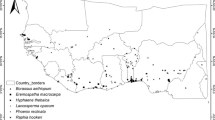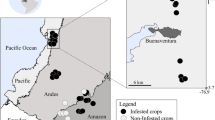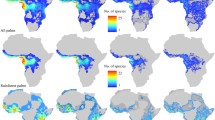Abstract
Wild palms contribute significantly to food security and local economy in tropical areas, and particularly in sub-Saharan Africa. In light of this importance, eight palm species were explored [Borassus aethiopum (L.) Mart, Eremospatha macrocarpa (G. Mann et H. Wendl.) H. Wendl., Laccosperma opacum (G. Mann et H. Wendl.) Drude, Hyphaene thebaica (L.) Mart, Phoenix reclinata Jacq., Raphia hookeri G. Mann et H. Wendl., R. sudanica A. Chev., and R. vinifera P. Beauv.] as targets for conservation, domestication, and cultivation in Benin. Cultivation potential was evaluated in a coarse-resolution, first-pass effort using ecological niche models to relate known occurrences of each species to vegetation indices (VEG), gross primary productivity (GPP), and soil characteristics (SOIL), and model outputs were related to human distribution and land-use patterns. Results showed that wild palms responded differentially to different suites of environmental factors: some species showed best model performance with VEG + GPP + SOIL, others with GPP + SOIL or VEG + GPP, or with a single factor. Two species had broad potential distributions across the country; others had potential areas in the north (2 species) or the south (4 species). Raphia hookeri and R. vinifera showed greatest overlap in terms of ecology and distribution, whereas L. opacum and R. sudanica had the lowest similarity. These models constitute initial steps toward a sustainable scheme for planning exploration of the possibility of cultivation of these species.







Similar content being viewed by others
References
Akoègninou A, Van der Burg WJ, L.J.G. VdM (2006) Flore analytique du Bénin. Blackhuys Publishers, Cotonou & Wageningen
Bekele-Tesemma A (2007) Useful trees and shrubs for Ethiopia. Identification, propagation and management for 17 agroclimatic zones. RELMA in ICRAF Project, World Agroforestry Centre, Eastern Africa Region
Belcher B, Schreckenberg K (2007) Commercialisation of non-timber forest products: a reality check. Dev Policy Rev 25:355–377. doi:10.1111/j.1467-7679.2007.00374.x
Bi IZ, Kouakou KL (2004) Etude de la filière rotin dans le district d’Abidjan (Sud Côte d’Ivoire). Biotechnol Agron Soc 8:199–209
Blach-Overgaard A, Svenning J-C, Dransfield J, Greve M, Balslev H (2010) Determinants of palm species distributions across Africa: the relative roles of climate, non-climatic environmental factors, and spatial constraints. Ecography 33:380–391
Cuni Sanchez A, Osborne PE, Haq N (2011) Climate change and the African baobab (Adansonia digitata L.): the need for better conservation strategies. Afr J Ecol 49:234–245. doi:10.1111/j.1365-2028.2011.01257.x
Ebanyenle E, Oteng-Amoako AA (2003) Anatomy and identification of five indigenous rattan species of Ghana. Ghana J For 11:77–90
Elith J, Graham CH (2009) Do they? How do they? WHY do they differ? on finding reasons for differing performances of species distribution models. Ecography 32:66–77
Fandohan B, Gouwakinnou GN, Fonton NH, Sinsin B, Liu J (2013) Impact des changements climatiques sur la répartition géographique des aires favorables à la culture et à la conservation des fruitiers sous-utilisés: cas du tamarinier au Bénin. Biotechnol Agron Soc 17:450–462
Fielding AH, Bell JF (1997) A review of methods for the assessment of prediction errors in conservation presence/absence models. Environ Conserv 24:38–49
Furze B, De Lacy T, Birckhead J (1996) Culture, conservation and biodiversity: the social dimension of linking local level development and conservation through protected areas. Wiley, New York
García-Callejas D, Araújo MB (2015) The effects of model and data complexity on predictions from species distributions models. Ecol Model 326:4–12. doi:10.1016/j.ecolmodel.2015.06.002
Giffard PL (1967) Le palmier rônier Borassus aethiopum Mart. Bois For Trop 116:3–12
Hijmans RJ, Cameron SE, Parra JL, Jones PG, Jarvis A (2005) Very high resolution interpolated climate surfaces for global land areas. Int J Climatol 25:1965–1978. doi:10.1002/joc.1276
Idohou R et al (2014) Biodiversity conservation in home gardens: traditional knowledge, use patterns and implications for management. Int J Biodivers Sci Manag 10:89–100
Idohou R, Ariño AH, Assogbadjo AE, Glele R (2015) Knowledge of diversity of wild palms (Arecaceae) in the Republic of Benin: finding gaps in the national inventory by combining field and digital accessible knowledge. Biodivers Inform 10:45–55
Katende AB, Birnie A, Tengnäs B (1995) Useful trees and shrubs for Uganda: identification, propagation and management for agricultural and pastoral communities. Technical Handbook 10. Regional Soil Conservation Unit, Nairobi
Lamotte M (2012) Trop Savannah Ecosyst Trop Ecol Syst Trends Terr Aquat Res 11:179
Mack R (2000) Cultivation fosters plant naturalization by reducing environmental stochasticity. Biol Invasions 2:111–122. doi:10.1023/A:1010088422771
Naughton-Treves L, Buck Holland M, Brandon K (2005) The role of protected areas in conserving biodiversity and sustaining local livelihoods. Annu Rev Env Resour 30:219–252. doi:10.1146/annurev.energy.30.050504.164507
Pearson RG, Dawson TP (2003) Predicting the impacts of climate change on the distribution of species: Are bioclimate envelope models useful? Glob Ecol Biogeogr 12:361–371. doi:10.1046/j.1466-822X.2003.00042.x
Pearson RG, Raxworthy CJ, Nakamura M, Peterson AT (2007) Predicting species distributions from small numbers of occurrence records: a test case using cryptic geckos in Madagascar. J Biogeogr 34:102–117. doi:10.1111/j.1365-2699.2006.01594.x
Peterson AT (2014) Mapping disease transmission risk: enriching models using biogeography and ecology. JHU Press, Baltimore
Peterson AT, Papes M, Eaton M (2007) Transferability and model evaluation in ecological niche modeling: a comparison of GARP and Maxent. Ecography 30:550–560
Peterson AT, Papeş M, Soberón J (2008) Rethinking receiver operating characteristic analysis applications in ecological niche modeling. Ecol Model 213:63–72. doi:10.1016/j.ecolmodel.2007.11.008
Phillips SJ, Anderson RP, Schapire RE (2006) Maximum entropy modeling of species geographic distributions. Ecol Model 190:231–259. doi:10.1016/j.ecolmodel.2005.03.026
Sidiyene EA (1996) Trees and spontaneous shrubs of the Adrar des Iforas (Mali). Orstom
Tabuti JRS (2007) The uses, local perceptions and ecological status of 16 woody species of Gadumire Sub-county, Uganda. Biodivers Conserv 16:1901–1915. doi:10.1007/s10531-006-9097-7
Warren DL, Glor RE, Turelli M (2010) ENMTools: a toolbox for comparative studies of environmental niche models. Ecography 33:607–611
Acknowledgments
This work was fully funded by University of Abomey-Calavi through Wild Palm project and the World Bank via a scholarship (RSM McNamara fellowship) provided to Rodrigue Idohou for a 6 months stay at the University of Kansas. We are grateful to the entire Biogeography and Macroecology lab group for fruitful exchange and support.
Author information
Authors and Affiliations
Corresponding author
Ethics declarations
Conflict of interests
The author(s) declare that they have no conflict of interests.
Rights and permissions
About this article
Cite this article
Idohou, R., Townsend Peterson, A., Assogbadjo, A.E. et al. Identification of potential areas for wild palm cultivation in the Republic of Benin through remote sensing and ecological niche modeling. Genet Resour Crop Evol 64, 1383–1393 (2017). https://doi.org/10.1007/s10722-016-0443-7
Received:
Accepted:
Published:
Issue Date:
DOI: https://doi.org/10.1007/s10722-016-0443-7




